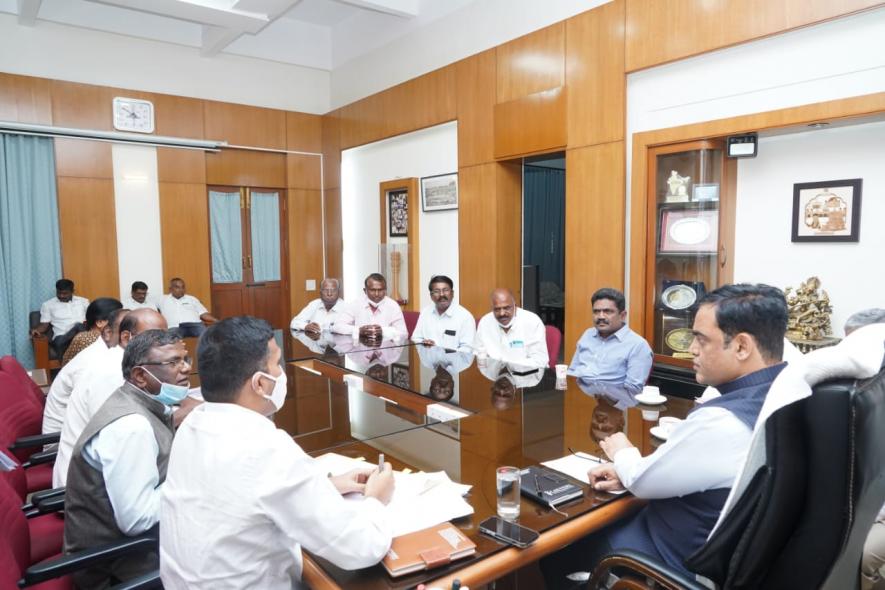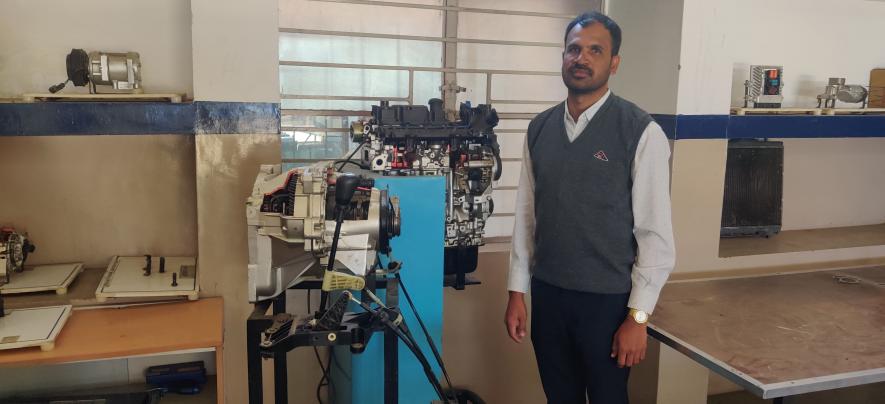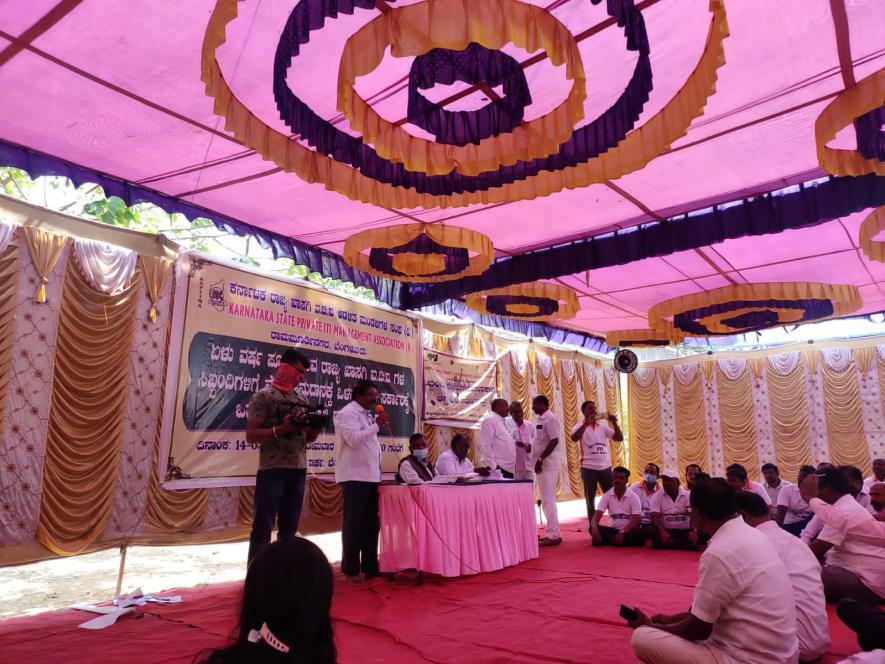
The ITI assc. members meet with minister Ashwath Narayana in his office
Junior Training Officers (JTO) in private Industrial Training Institutes (ITIs) are facing a severe pay disparity. It is not uncommon to find a JTO (Junior Training Officer) earning around Rs 60,000/month, while another JTO in the same institute earns a paltry Rs 8000/month. They are both working in the same ITI, and doing the same job, yet their pay scales are vastly different. This is because the higher-paid JTOs are recipients of government grants-in-aid. Their salaries are paid directly by the state government of Karnataka, while the others are paid by their employer.
Skilled workers are the fundamental units of the ‘Make in India’ vision. Across the country, ITIs are attempting to realise this goal by providing vocational training to people who are unable to pursue full-time engineering courses. These institutes offer practical, skill-oriented courses and familiarise students with industrial equipment. Some of these ITIs are run by the government. However, private, unaided ITIs in Karnataka have been unwilling to pay a living wage to their teaching staff.
SS Mathad, 54, is a JTO at SJMVS ITI College, Hubbali, and teaches engineering drawing, workshop calculation and science. Speaking to NewsClick, he says, “Our institute received the grant-in-aid in 1997. I joined in 2006, and hence, I was not eligible for the grant. Today, nine members of staff in our institute are getting the grants – Engineering drawing JTO (1), Draughtsman-Civil JTO (2), Electronics Mechanic JTO (2), principal (1), clerk (1), workshop attender (1), and peon (1).”
He says about the pay disparity, “The senior JTOs who receive government grants earn around Rs 85,000/month. The Principal earns over a Lakh/month. The institute also offers two more trades – Fitter and Fashion Design. But the grants don’t cover these courses and their respective JTOs earn around Rs 6000/month. I also teach in the Draughtsman (civil) course, but I earn Rs 7000/month. I have three children. My daughter is pursuing MSc, another daughter is pursuing engineering, and my son is in school. To support the family, my wife teaches Kannada and English in a private school. It is an injustice that only three JTOs in our institute do not receive grant payments.”
The ITIs are regulated by the National Council for Vocational Training (NCVT). The size of a batch of trainees (for all trades) has been capped at 20. This limits the amount of revenue an institute can generate from one course. Further, most of the students who take up vocational training come from working-class families and would not be able to afford expensive courses anyway. So the fees would have to remain low. Outside Bengaluru, the Junior Training Officers (JTO) at these institutes earn between Rs. 5000-10000/month. This is below the stipulated minimum wages of construction workers in Karnataka. While JTOs in rural areas are earning minuscule wages, their counterparts in Bengaluru only fare slightly better, with salaries ranging between Rs 10,000-20,000/month.
The Karnataka State Private Industrial Training Institutes Sangha has appealed to the government to provide grants-in-aid to private, unaided ITIs. In 1997, the government announced that private ITIs registered for more than seven years were eligible for government grants-in-aid. These grants would cover 75% of the wage bill. The balance would be paid by the management. This would free up finances for the institute to invest in new machinery and tools. However, members of the ITI association claimed that this was done to provide a safety net to private ITIs on the verge of financial ruin. The limit on the batch size, along with low fees and high investments, resulted in the erosion of profits. In 2007, the grants-in-aid were enhanced from 75% to 100% and covered the entire salary for the selected trades.
The JTOs have been training students for more than 15-20 years. They are technically qualified teachers who have degrees and diplomas in Engineering. They argue that they would not have continued working with private, unaided institutes if they knew they would never receive grants. According to the commissionerate of Industrial Training and Employment, there are 1,492 ITIs in Karnataka at present; the break-up is as follows:
Private (unaided) ITIs – 1,030
Government-run ITIs – 270
Private ITIs (receiving grants-in-aid) – 192
As per data shared by officials at the commissionerate, the grants were paid to 196 private ITIs in 2010. The number then dropped to 192 as four institutes had closed down. The grants paid to 196 institutes had been supporting 2,412 people, including 1,326 junior training officers (JTO) and 54 training officers (TO).
Finding a Second job to Survive
Iradaali Hallur Talikoti, 52, is a JTO at VVS Balashetty ITI college in Talikoti (Vijayapura district). He is a double-diploma holder in Mechanical and Automobile engineering. He teaches the ‘Turner’ course and has been working at the same ITI since 2001. He says, “After my duty as a JTO, I go to work as a loan recovery agent for a bank because my salary is only Rs. 8000/month. In our institute, we teach four trades – Turner, Fitter, Electrician and Welder. There are 15 members of staff who receive grant payments from the government. And another 7 staff are paid directly by the institute. With my salary, it becomes difficult to run my household. I have four young children. That is why I had to get a second job.
The JTOs who receive grants-in-aid, earn salaries that are at par with state government employees. It is a considerable sum. The grants also apply to non-teaching staff such as office supervisors, workshop attendants and peons.
Making Ends Meet in Bengaluru
NewsClick visited the Loyola ITI in Bengaluru to understand more about the issues faced by JTOs. The JTOs at this institute earn a little more than their rural counterparts. Mahesh, 36, an Electronics Mechanic JTO, has been working at the institute for the last eleven years. In this trade, students are trained to repair televisions, radios, computers and solar-powered appliances. He says, “I have a diploma in Electronics & Communications Engineering and earn Rs. 16,000/month. I have to pay rent as well. It becomes difficult to survive. In our electronics department, the institute has invested close to Rs 10 lakhs on equipment alone. So, the fees paid by trainees do not cover all the expenses borne by the management.”

JTO Mahesh and Motor Vehicle equipment at Loyola Institute
Mary Veronika, 44, is the principal at Loyola ITI. She says, “there are 17 members of staff at this institute. The management is paying the salaries of 15 members, the other two are receiving grants-in-aid. This grant was approved in 2010 and only two trades were considered – fitter and electronics mechanic. Their salaries are close to Rs 60,000/month. The other staff members are earning a quarter of that salary.”
Loyola Industrial Training Institute has been operating since 1992. They offer three trades – Electronics Mechanic, Fitter and Mechanic Motor Vehicle. The institute was started by the ‘Karnataka Jesuits’, a society which runs educational and religious institutions across the state. Due to the financial heft carried by the society, they are able to pay their employees slightly higher salaries compared to their rural counterparts. However, the high cost of living in Bengaluru cancels any potential savings.
Scope for ITI Trainees
Mary Veronika says that the job opportunities for trainees have doubled in the last 10 years. She says, “The companies tell us that they are looking for 100 candidates, but we can provide them only 20 at a time. The demand had dropped slightly after covid, but things are better now. We also tie-up with companies for advanced training. The trainees are equipped with enough skills to set up their own businesses as well.”
Heavy Investment
The institutes would have to make a sizable investment in infrastructure in order to meet the basic requirements of the students. Trainees in the Mechanical Motor Vehicle trade would require a garage with genuine motor vehicle parts. Similarly, raw materials like sheet metals and other raw materials are needed for welding. Trainees in the ‘Fitter’ trade would require a lathe, drill machines and other tools. The institute must procure the items in advance to receive approvals from the Directorate General of Training (DGT). However, it appears that manpower is the only area where cost-cutting has been made. ITI management have been exploiting the staff in order to try and recoup their investments.
Thomas Commission Report
Retired IAS officer Thomas had submitted a report to the state government in 2007. His report recommended that the benefits provided to aided ITIs must be extended to private, unaided ITIs as well. He also recommended that institutions registered for more than five years should receive grants-in-aid for staff salaries. By those parametres, every private ITI in Karnataka would become eligible for grants.
However, in 2010, the state government, under BS Yeddyurappa announced that there would be no new grants-in-aid considering the poor financial health of the state government. Even an alternative was proposed, known as the ‘child-centric scheme’. As per this scheme, it was proposed that for every trainee who completes the course, the government would pay a sum of Rs 6,000 into a single fund. This amount could then be shared by all the staff members equally. However, this proposal was rejected by all the ITIs. They feared that if the intake was too low, the payout would be too little. They preferred the staff-centric scheme, where the government approves grants for a fixed number of staff members, irrespective of the number of trainees at the institutes.
The movement for grants-in-aid
In 2011, ITI staff members began the movement against the child-centric scheme. They insisted that grants-in-aid be extended to all unaided institutes (based on the 1997 rules). At least three different ITI associations have been set up to provide a platform for the protestors. They have held several protests over the years to highlight their position. In 2017, they held a big protest at Suvarna Soudha, Belagavi, during the winter session of the Assembly. Earlier this year, in February, they held protests at Freedom Park, Bengaluru. Following this, 50 members undertook a padayatra from Hubbali to Bengaluru. They say that they took 14 days to cover the distance. When they arrived in Bengaluru, they met with Ashwath Narayana, the Minister for Skill Development, Entrepreneurship and Livelihood. They say they have been ably supported by Arun Shahapur, a former MLC, representing Belagavi, Bagalkot and Vijayapur (Bijapur). He, too, was present in the meeting.

K Jyothi, Commissioner at the Commissionerate of Industrial Training and Employment (in Bengaluru) addressed the issue. Speaking to NewsClick, she said, “This is a policy decision to be taken by the government. There are 192 private ITIs receiving grant-in-aid and this is costing around Rs 200 crores every year. Since the cost is too large, the government has decided not to extend grants to any other ITI. Privatisation is good as long as the management is able to pay salaries. If they cannot pay salaries, they should shut down the institutes. They cannot play with the lives of people by paying low salaries. Further, the ITIs should consider the ‘child-centric scheme’, which was suggested in 2010.”
When asked whether the meagre salaries paid to the staff was a violation of minimum wage rules, she said, Tthe teaching staff are not labourers, so the minimum wage rules do not apply. However, If a private ITI is appointing a principal, they should ensure that the salary is equivalent to that of a principal in a government institute.”
SM Nerabenchi, 54, Chairman of the Karnataka State Private Industrial Training Institutes Sangha, has been one of the leaders of the movement since 2011. He set up the Sangha in 2016. He is the principal at Bapuji Vidyavardaka Sangha ITI, Bijapur. Though he has a degree in Engineering, his salary is Rs. 10,000/month. In order to be a principal at an ITI, one has to have an engineering degree, whereas diploma holders are eligible to be JTOs. However, both of them are unable to earn a living wage today.
Courtesy: Newsclick